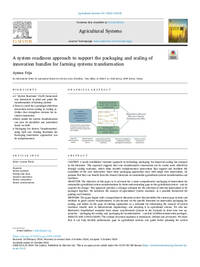A system readiness approach to support the packaging and scaling of innovation bundles for farming systems transformation

Authors:
CONTEXT: A newly established ‘systemic approach to technology packaging’ for improved scaling has emerged in the literature. This approach suggests that core transformative innovations can be scaled more effectively through scaling readiness, which helps identify complementary innovations that support and facilitate the scalability of the core innovation. Since these packaging approaches start with single core innovations, we propose that they can benefit from the broader literature on sustainable agricultural systems transformation and readiness.
OBJECTIVE: The objective of this paper is to advocate for a more comprehensive packaging of innovations for sustainable agricultural system transformations by better understanding gaps in the agricultural system – and its capacity for change. This approach provides a stronger rationale for the selection of relevant innovations to be packaged together. We introduce the concept of agricultural ‘system readiness’ as a possible framework for guiding such bundles.
METHODS: The paper begins with a comprehensive literature review that identifies the current gaps in tools and methods to guide system transformation. It also focuses on the specific literature on innovation packaging for scaling and builds on the gaps of existing approaches as a rationale for introducing the concept of system readiness (mostly used in infrastructure engineering) and adapting it to agricultural science. We also use illustrative hypothetical examples from mixed crop-livestock systems in the drylands to show how two approaches – ‘packaging for scaling’ and ‘packaging for transformation’ – can lead to different innovation packages.
RESULTS AND CONCLUSIONS: The concept of system readiness is introduced, defined and advocated. We show that it can help identify performance gaps in agricultural systems and guide better planning for system strengthening and integration. We conclude with possible complementarities between the two approaches of scaling and system readiness. SIGNIFICANCE: The agricultural system readiness approach, as outlined in this paper, would be particularly beneficial for agricultural research-for-development, as well as other agricultural investment programs that seek to identify strategies for fostering sustainable transition in farming systems. Such programs would typically entail complexity-aware theories of change that focus on stimulating sustainable transformation pathways related to key target areas, such as agroecology, sustainable intensification, and system integration (e.g., crop-livestock integration and integrated pest management). The system readiness approach can support such programs through the identification, prioritization, targeting, and empowerment of the most significant (and transformative) system components by identifying respective innovations to be packaged.
